On Saturday July 3rd we left around six AM. We drove via Hengelo, Osnabrück, Hannover, Magdeburg and
Leipzig towards Dresden. Along the way, the weather varied from moment to moment, from heavy rain showers to sunshine.
Around 2:30 PM we arrived at our hotel in Dresden, Hotel-Pension Kaden. Apart from the owner there was no personnel in the
hotel. She took us to our room. After we had some rest from the tiring journey we took the tram to the Altstad of Dresden. In the meantime, the
weather had changed completely into a bright blue sky. Around 3:30 PM we arrived in the centre of Dresden. There was some kind of
festival, booths and music everywhere. We walked along some of the sightings of Dresden, like the Frauenkirche that is being restored
(from the damage of WW II!), the cathedral, the Semper opera, the Stallhof and of course the most famous sight of all, the Zwinger.
There is a lot of restoring going own in Dresden; most of it is still repair work from the damage of WW II that had not been carried out
in the DDR (former Eastern Germany) era. After a great dinner, outside, on a terrace as the weather was still great, we took the tram
back to our hotel. On the way the our hotel it started to rain again.
The following day we left after breakfast around 9:15 AM. The weather looked promising, again a bright blue sky with some friendly
white clouds. Just after ten o'clock we arrived at the German-Polish border. We didn't have to wait very long. In just under 10 minutes
we set foot at Polish soil. But unfortunately, the highway ended right after the border and we continued our way via local roads through
small villages and towns. Ciska, seeing all the old houses, wondered if there were actually people living in those old houses.
After about 60 km we thought we would arrive at the highway towards Wrocław. We did, but the road is still under construction, so
most of the way is still a bumpy 2-lane road on which overtaking is impossible. Some parts are finished so on those parts you can make some
progress. Finally, around 1 PM we arrived in the centre of Wrocław where we parked our car and continued by foot.
First we went to the central square called Rynek. This square has been beautiful restored and is loaded with all kinds of restaurants.
At the Tourist Info we picked up a map of the town and then we walked to the university where we saw, among other things, the Leopoldine Hall.
We also climbed the tower of the university from which you have a nice view over Wrocław. From the university we walked
to the Raclawice Panorama, a gigantic rotunda accommodating a 120 meters wide and 15 meters high panoramic painting which represents
the battle of Raclawice in 1794 between Russian troops and Polish rebels. Via a headphone you can get explanations in several languages.
When we left the Panorama it was already 5 PM so we went back to our car to continue out journey towards Kalna, a more than 3-hour drive
from Wrocław. From Wrocław onwards the highway is finished and all the way to Gliwice it is a four-line highway where progress can
be made. The highway ends at Gliwice and from there on you are mostly on local roads. Around 8:30 PM we arrived at Villa Kotlina
in Kalna where we were welcomed by the friendly Dutch owners, Kees and Gerda. This pension is no longer operating.
Outward journey to Poland

The Brühl terrace with the academy of arts

The world-famous Semper opera of Dresden

The splendid Rynek square in Wrocław

Again the Rynek square

The old town hall of Wrocław
Kalna - Villa Kotlina
The next day we didn't do very much apart from resting from the journey of the past two days and exploring the direct surroundings of Villa Kotlina.
Ciska played some games and helped Gerda. After lunch we left to pick bilberries for desert. While doing that, it started to rain so we decided to
have a drive through the countryside. We wanted to see the old wooden church in Szczyrk, but the rain was really pouring so we decided to go back to
Kalna and it also started to thunder. An hour after we were back in Kalna the weather cleared and the sun was shining again.

Ciska helping Gerda doing the laundry

Picking bilberries

View from Villa Kotlina
Wieliczka and Chabówka
The next day, the sky was grey and it was raining. For this day we planned to visit the old city of Krakow, but the weather didn't invite us to do a citywalk.
But still we left for Krakow, maybe the weather will change. Along the way we stopped at a beautiful wooden church in Gilowice. The closer we
got to Krakow, the more it poured. So we decided to go to Wieliczka, a town about 15 km southeast of Krakow that is famous for its salt mine.
And as a mine is underground, and hence dry, a very suitable tourist destination for a rainy day like this one. If you visit the mine by car, ignore all people
and signs inviting you to park your car, just continue until you reach the mine and park your car at the premises of the mine, it will save you a long walk.
At 12:30 PM we descended, guided by an English speaking guide, into the mine. First we had to walk down 54 stairs with a total of 378 steps to a depth of 64 metres
below surface. After that we descended slowly to a depth of 135 metres below surface. In the mine, a lot of chambers are cut out in the salt and a lot of them
have beautiful sculptures, also made of salt of course. The most impressive area is the chapel of Saint Kinga, a complete church hewed out in the salt
(made in the 19th century!) at a depth of 100 meters of 54 meters long and 10 metres high. A chapel with salt statues and also the famous painting
The Last Supper by Leonardo da Vinci, in salt of course. Even the chandeliers are made of salt. The lowest point in the mine is at
327 meters under ground and the galleries span a total of 250 km. As a tourist you only see a few percent of them during the 2-hour tour.
The ascend to ground level is by a means of a (narrow) elevator. Back at ground level it turned out that it had stopped raining. As we agreed with
Kees and Gerda not to have dinner with them we decided to visit something else. So we went to the railway museum near Chabówka. Our
guidebook didn't have any opening hours, but it turned out to be open until 7 PM. The museum (called Skansen) has a large collection of steam locomotives,
most of them are still in good shape. We walked around for an hour or so before we left to have dinner.

Horses were used a lot in the Wieliczka saltmine

Elevator for lifting large blocks of salt

Overview of the Kinga chapel


Snow plough and steam locomotive in the museum (Skansen) in Chabówka
Żywiec
The next day the sun was shining in a clear blue sky, quite a difference compared with the previous day.
In the morning we went to Żywiec, a town not far from Kalna and known for its brewery where the famous Polish beer with the same name is brewed.
On Wednesday there is a local market in Żywiec where all kind of products can be bought. There is also some livestock for sale like chickens,
piglets, calves, rabbits etc. When you buy a small animal like e.g. a rabbit, you'll receive in a plastic bag. So on the market you will see a lot of
people walking with a moving plastic bag containing a rabbit or a chicken. From the market we drove on to the centre of Żywiec to see the
most important sights of the town. In the park we went to the castle, a bit rundown, it definitely needs to be restored. In the castle there was an
exhibition about spiders and scorpions which we visited. Luckily most of these creepy creatures were caged. At the entrance, the boy that sold the
tickets had a tarantula spider walking around on his desk. Visitors were allowed to stroke it or to put the spider on their hand. Ciska and Hilleke
didn't like the idea of doing that, but Arjan indeed had the spider on his hand and stroke it. This gave Ciska and Hilleke the creeps. After the
exhibition we walked through the centre of the town and had something to eat on the central square before we went back to Kalna.
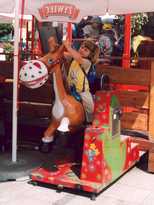
Ciska on the central square in Żywiec
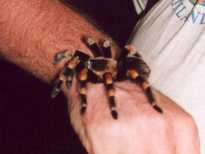
Tarantula spider on Arjan's hand
Auschwitz
A visit to Auschwitz is not the most fun excursion during a holiday, but when you are so nearby you can not ignore such an important piece of
human history. So after our visit in the morning to Żywiec we drove in the afternoon towards Oświęcim, the place of the former concentration camp
Auschwitz-Birkenau. We left Ciska this afternoon with Gerda because a visit to Auschwitz is not suitable for a five-year old girl. At the entry of the
former concentration camp there is also a sign saying: "Children below the age of 14 do not belong here", although it is not forbidden. In all of the world,
Auschwitz has become the symbol of the terror and genocide of the Nazis in the Second World War. It is the largest murder-factory in the history of mankind.
You enter the camp through the gate with the cynical text "Arbeit Macht Frei" (Labour Liberates). In a number of the former, rebuild, barracks there are
exhibitions showing all what happened in the camp during the war. The walls of the corridors in the barracks are full with thousands of pictures with the
names of the victims. Very impressive was also the room with hundreds of suitcases bearing the name and sometimes birth date and residence of its owner. There
is also a room with thousands of shoes, from small child's shoes to wooden shoes. A room containing thousands of hairbrushes, shaving-brushes, toothbrushes, etc.
All personal belongings of people that died a cruel death in this camp. It is really unimaginable. Beneath some of the barracks there are long corridors with
prison cells to lock up the people that were condemned to death . There are also 'standing-cells', a small dark room of less than one square metre that could
hold up to four people who had to stand in them for hours or even days without light and fresh air. You can't imagine how it was like for the prisoners in those
cells, really degrading conditions. Outside the barracks you then sometimes see people, sitting on the ground or a stair, crying from all emotions. Next to some
of the barracks also one of the crematoria has been rebuild with next to it a mortuary that could also be used as a gas chamber. While we were there, there was
a group of Jewish people standing at one of the incinerators, doing a memorial for the many Jews that died in this camp during the war. Besides the camp of Auschwitz
there is also the much larger camp of Auschwitz II - Birkenau. We didn't go there because a) it was already late in the afternoon and b) we already had seen
enough human sufferings. So after we left the camp through the infamous gate we drove back to Kalna. There Ciska had a great afternoon picking black currants and
strawberries in the garden of Villa Kotlina and baking cake with Gerda. She also helped her making the lasagne for dinner.
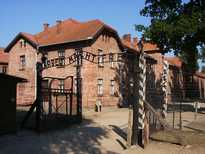
"Arbeit Macht Frei" (Labour Liberates), entry into Auschwitz
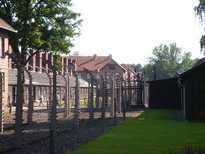
Two high-voltage, barbwired fences had to prevent that people escaped from the camp
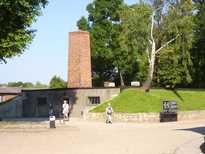
Crematorium in Auschwitz with the mortuary annex gas chamber
Krakow
On Thursday the 8th of July we made a second attempt to visit Krakow. At least the weather looked much more promising than two days before. The sun
shining in a clear blue sky. We followed a tourist route that Kees had given us and after about 2 hours we arrived in Krakow. First we walked to
the Rynek Główny (Main Market Square) where we visited St Mary's Church. A typical example of exaggerated catholic pomp and circumstance,
the choir is dominated by the most important piece of art of the church: The monumental High Altar of Wit Stwosz (Veit Stoss). After the visit to the
church we walked through the Cloth Hall (Sukiennice) from where we walked to the Florianusgate and back through the Florianska street to the main
square and continued towards the Wawel. Until the 17th century the Polish empire was governed from this citadel. We visited the cathedral, the
construction of it started in 1320 after the previous one cathedral was destroyed by fire. We also visited the crypt in which the Polish Royal family
is buried. We also climbed the Zygmunt tower which holds the largest bell of Poland, the Zygmunt (Sigismund) bell, it has a diameter of
2.4 metres and weighs 6 tons. From the cathedral we went down in the Dragon's Den below the Wawel. According the legend once a large fire spitting
dragon lived in this cave. Each week it was fed a large amount of cattle to prevent that it would start eating people. King Krak back then promised that
the one who would defeat the dragon was allowed to marry his daughter. Skuba, a poor cobbler, went to the king. He filled a lamb's fleece with sulphur
and laid it in front of the cave. The dragon ate it and soon after the whole castle shook to its foundations because of the roaring dragon. It went to
the river and drank until it exploded. Then there was a large wedding-feast in the castle for the wedding of the princess and the cobbler. In front of
the Dragon's Den there is a large bronze dragon. From the Wawel we walked back to the Rynek Square to have something to eat before we went back to Kalna.
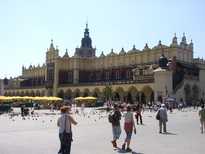
The Cloth Hall on the Rynek Główny in Krakow

St Mary's Church on the Rynek Główny
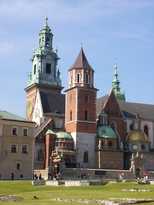
View on the cathedral in the Wawel
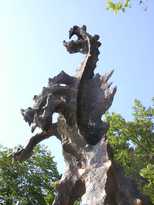
The dragon in front of the Dragon's Den below the Wawel
Bielsko Biała
On our last day in Poland we went to the largest town in the region, Bielsko Biała, not far from Kalna. This day we first had a sleep out, because
the last days we could as we had to get up early because of the long driving times in Poland. Bielsko is not a large city from a tourist point of view,
so after a short time we had seen the most of it. We walked around on the Rynek and admired the house with the frogs (Pod Żabami). Via the castle
and the cathedral (not very interesting) we went to the Weaver's House. This one we also visited, it's an old house with tools that were formerly
used in a weaving-mill. After visiting the weaving-mill we went to a bakery to eat some bread for lunch. Somewhere arounf three in the afternoon we
were back in Kalna. Back home, Ciska helped Gerda with the preparations for dinner this evening, pancakes, normal and Polish ones. The latter ones
contain a sausage and have cheese on them before they are put in an oven. You then eat them with ketchup on them. In the evening Kees and Gerda
had planned to have a camp-fire in the back of the garden, but during dinner it started to rain, so the camp-fire could fall to the ground. But it
was only a short shower, so later that evening, after it had turned dark Kees started the fire and we had really good sausages. Ciska didn't dare
to put her sausage above the fire, so Kees did it for her. We really had a nice evening around the camp-fire in Kalna before we would set off for
Slovakia the next day.
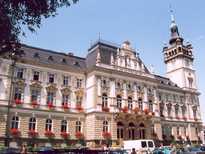
The town hall of Bielsko Biała
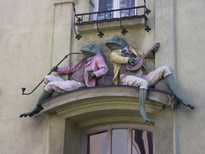
The frog house

The Weaver's House in Bielsko Biała
On our way to Slovakia
Saturday the 10th of July. After we had breakfast and loaded all our luggage into the car and after we had paid the bill and Kees photographed us for
his electronic guestbook we left around half past nine. Kees had given us an alternative route towards Slovakia via the town of Zakopane. After a
ride through a beautiful countryside we arrived around noon in Zakopane, a very busy tourist destination. We had lunch there and we also spent our last
Polish money. Also Ciska spend her last money on a beautiful wooden box and some necklaces and bracelets. When it started to rain we went back to the car
to continue our drive to Slovakia. Around two we left Zakopane and after again a beautiful ride, with some rain now and then, we arrived at the
Polish-Slovak border. Also here we didn't have to wait very long, within 10 minutes we were at Slovak soil. The first things we noticed is that the
roads are much better here than in Poland, but the road signs are not very clear. Some are very small and sometimes even the larger places are not
mentioned on the signs. We first drove through the High Tatra Mountains, a nice mountainous area with snow on the higher mountains. After we had left
the High Tatras we came in a more flat area, but only a short time after we were again surrounded by the hills and mountains of the so-called
Slovak Paradise. After a long ride south through the heart of Slovakia we finally headed east towards the town of Košice via highway 50 (E571).
This is a quiet road and not very winding so we finally could make some progress. We now drove parallel to the border with Hungary. Near Moldava we
left the highway to continue on local roads via Jasov to Medzev. In the latter town we saw an ATM so we were able to draw our first Slovak crowns.
From Medzev it was only a short drive to Vyšný Medzev to our apartment in a rebuild farm. We were kindly received by Jana and Harrie.
Harrie told us something about the surroundings and what there is to see and do. After that we installed ourselves in our apartment. A nice 2-room
apartment on the first (Am. second) floor. Then we went down again to have something to eat and discussed with Harrie some of the things we could do the coming days.
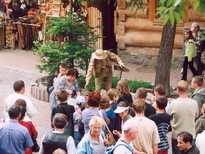
Mime artist in Zakopane
Košice
After a delicious breakfast and some deliberation with Harrie we left for the town of Košice, not far from Medzev. It was a bit difficult to
find the centre of the town, the road signs as well as our map were not very clear on this point. After some driving around we arrived at a place we'd
seen before and we decided to park the car and walk from there. It turned out we indeed were in the centre of town. The Hlavná is a completely
restored street which has most of the tourist sights of the second largest town of Slovakia. First we entered the St. Elizabeth's Cathedral, a very
beautiful gothic cathedral which is also being restored. It is very beautiful on the inside. After a short visit to the cathedral we continued our walk through
the main street of Košice. Today is Sunday and it is very quiet in town. Not many people in the streets, the shops are closed, even the Tourist Info
booth was closed. The façades of the buildings in the street, they are all very magnificent. At a bar we had something to drink, two coffees and some
lemonade for Ciska and three pieces of cake. This all for a total of 100 SKK, which equals 2.50 euro. After that we did some more walking before we took a rest near
the water organ, a large fountain in front of the theatre which spouts in the rhythm of music. For the local youth it is a challenge to walk into the fountain
and to try to stay dry. Which of course is not possible and everybody enjoys it to them getting their clothes wet. In a booklet we borrowed from Harrie there was
a Children's Railway mentioned (Čermel Valley Railway). That we tried to find, which was not easy as the Tourist Info was closed. Finally we succeeded to find the train just north-west of the
town. We arrived at the small station at around a quarter to three and the train didn't leave as early as 16:05. So in the meantime we has something to drink
at a nearby booth. Around a quarter to four we walked again to the station. The train now already was at the station and people were already boarding. At exactly
16:05 the small steam train left for the short 15 minutes ride. For this we had to pay 26 SKK (€ 0,65). At the terminus at Alpinka we got off the train. There you can find
a large playground with a restaurant. We first had the plan to eat something at the restaurant and then return. But we decided to take the next train back and
drive with our car to the restaurant so we had better planning of when to get back instead of being bound to the train schedule. So we went back with the train and
back at the beginning we took our car for a very short drive to the restaurant. Ciska there enjoyed herself very much in the playground while we had something
to drink in the shade. When the bar closed we walked to the nearby restaurant for dinner before we headed back to our apartment.
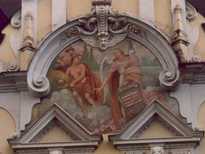
Painting on a façade in Košice
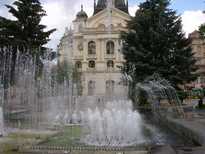
Fountain in front of the theatre in Košice

The local youth gets wet in the fountain

Ciska in the Children's Railway near Košice
Spišský Hrad
When in Slovakia, a visit to Spišský Hrad can not be missed. Spišský Hrad is the largest castle ruin of its kind in Europe. Via small winding
roads we drove in just under two hours to the castle. On the way Ciska complained about stomachache and just after that she said she had to vomit. For this we always
have a special vomit-towel with us (experience) and at the first possible place we stopped. At the moment we dragged het from the car she started vomiting, luckily
everything ended up in the towel and not directly in the car. When she felt a little better we continued. When we arrived at the parking place of the castle she had
to vomit again. When all was dome we had to do a steep climb to arrive at the castle itself. It took us about 20 to 30 minutes to climb up there. It is an extremely large
and impressive castle ruin, the original castle burned down in 1720. We walked around there for a few hours (it is really that big) to see the whole castle and the
accompanying museum. When we were ready with our visit we had something to eat before returning to our apartment via Presov and Košice. This is all highway and
not small winding roads to prevent Ciska from vomiting again. We also wanted to visit the caves in Jasov, near Medzev, but they were already closed so we returned
back to Vyšný Medzev as there would be a camp-fire with dinner at six. In the evening we had a camp-fire with sauerkraut soup, prepared by Jana, a Slovak
speciality, amongst other Slovak dishes. While we were having dinner it started to rain so we all went to the brand new covered terrace where we had a really nice companionable
evening with Harrie, Jana and the other guests.

The impressive castle ruin of Spišský Hrad
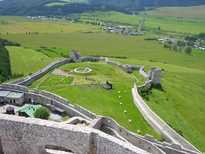
View on the surroundings from Spišský Hrad
Caves, caves and more caves ... and a monastery
When you are in this area of Slovakia you have to visit the Slovak Paradise and the Dobšiná ice cave. The next day, the weather looked very promising for a
nice walk in the Slovak Paradise. So we left early and around 10 o'clock we arrived at the parking place of the Dobšiná ice cave. The sky, by the way, looked
much more threatening than when we left Vyšný Medzev this morning. From the parking place it is long walk to the entrance of the cave. You have to climb a steep
hill. It turned out we have to climb a total of 160 metres to a height of 969 metres above sea level. When we were almost there, it started to rain and before we reached the
entrance it really poured down. There were a lot of visitors and not everybody was able to find a dry place under the roof of the cave info centre. At eleven a group entered
the cave, we had to wait for the next group. But fortunately some time later they allowed another large group to enter the cave, probably because of the rain. Normally only one
small group per hour is allowed to enter the cave. Inside, the cave is a beauty. There are large ice fields and large columns of ice. Only the temperature inside the cave is
rather cold, just below freezing-point. The only disadvantage was our guide, he only explained in Slovak. One of the advantages of the large was the fact that Arjan could
use its camcorder. Normally you have to pay 300 SKK to be allowed to use one and that was a bit too expensive. But because of the large group the guide was not able to check
it all. The tour takes about half an hour, luckily the raining had stopped when we leaved the cave and we stayed dry when walking down. Back down again we had something to eat
and drink in a restaurant before we left. As the weather didn't invite us for a nice walk in the Slovak Paradise we had to think of something else to do. Near the restaurant
was a large sign about the aragonite cave of Ochtiná. So again a good thing to visit on a rainy day. At 14:00 we arrived at the cave, not far from Dobšiná.
There we had to wait for one hour for the next tour into the cave. While waiting we had something to drink in the hall of the information centre and we read some information
about the cave. In the entire world there are only three known of these aragonite caved, so it really is a rarity.
At 15:00 we entered the cave, also now guided by a guide who only explained in Slovak. It's clear that in Slovakia tourism is still not very internationally
oriented. But who needs words when in a beautiful cave like this one, it is almost impossible to explain what an aragonite cave looks like. Everywhere on the ceiling, the
walls and in holes there are a kind of white cobwebs and things that looks like a sea-anemone or coral. And sometimes it looks like mould. Another time they are whimsical
prickles that hang from ceiling and look likes flowers, it is really beyond any description. This is something you have to see with your own eyes. Also in this cave the whole
tour lasts for about half an hour and around four pm we left. As we had no plans for the rest of the day we just drove around. At one moment it was dry and sometimes later
the rain poured down, sometimes even with some thunder. Around six we arrived in Rožňava where had an extensive dinner for the total amount of 716 SKK (18 euro).
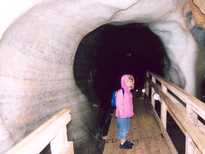
Ciska in a tunnel of ice in the Dobšiná icecave
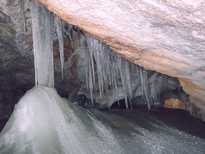
Enormous columns of ice and icicles
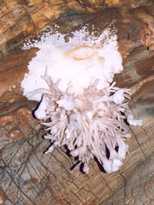
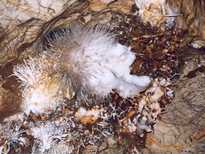
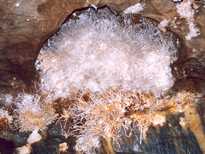
Unreal formations in the Ochtiná aragonite cave
The next day we went to Jasov, about 7 kilometres from Vyšný Medzev, to visit the monastery and, again, a cave. First we went to the monastery, the largest
monastery in all of Slovakia. Unfortunately only the church can be visited. All other parts of the monastery, including the garden, are closed to the public. In the church,
dedicated to John the Baptist, a lady gave us a private tour and she told us everything about the splendid interior what tells about the life, from birth to death, of
John the Baptist. Unfortunately we were not allowed to take pictures or video inside the church. From the monastery we went to the stalactitic cave of Jasov. Good choice as it
again looked like as it was going to rain. This is the third cave in two days. Again we had a guide that only explained in Slovak. The cave, like all stalactitic caves, has many
stalactites and stalagmites. Also several, smaller, halls where one can see all kind of shapes and figures in the sinter. These caves were already used in the 15th century as a
hiding place during the Hussite wars. These people wrote their names on the walls of the caves and they tell about the victory of Jan Jiskra over the armies of Jan Hunyadu
near Lucenec in February 1452. After the one-hour visit to the cave we had lunch in the nearby restaurant.

The beautiful church of the monastery in Jasov

Whimsical shapes in the stalactitic cave of Jasov

Another picture of the Jasov cave
Zádielska Dolina
After lunch we drove to a place called Zádiel where we did a walk in the Zádielska Dolina, the gap of Zádiel. Luckily the sky had cleared up, no more traces of
rain or dark clouds. We made a magnificent walk through the 3.5 km long gap, between high rising rock-faces and along a lovely murmuring brook, to a restaurant. This restaurant
is a typical example of departed glory from the Soviet Bloc era. A concrete box without windows and a few steel doors, it didn't look very inviting. It was closed so we ate our apples on one
of the benches that stood outside. Some time later it turned out that someone was present in the box and we bought something to eat and drink. Following a short rest, Arjan and Ciska
decided to climb up the rocks. Hilleke stayed below as it was a rather strenuous climb and she still suffered from the blisters she contracted during the climbs of the previous days.
After a strenuous climb of about half an hour, Arjan and Ciska arrived at the top of the rock. Along the way, Ciska had to take a few rests, but the climb was definitely an achievement
for a five-year old girl. Once above, we had a magnificent view over the surroundings and as the sky was clear we could see very far, way into Hungary. After about a quarter of
resting and enjoying the view we went back down which went much faster. In the meantime, Hilleke had enjoyed the beautiful weather and the squirrels in the wood. Back down again we had to
walk another 3.5 km back to the car. Along the way we heard a moped or something like that coming our way. But before we could see it, we heard a loud crash and then nothing.
A moment later we saw two men climbing from the verge. When we arrived there we saw that they had driven from the slope with their old Jawa motor-cycle and had ended up in the
shrubs, two metres below the road surface. In Slovak they asked Arjan if he could help them to get the motor-cycle back on the road. In the meantime Hilleke and Ciska could take
care of the rabbit they carried in a shopping-bag. They were afraid that it might escape otherwise; the rabbit was probably their dinner. After some troubles Arjan and the two men
succeeded in pushing the motor-cycle back onto the road. One of the men was still searching for some tools he had carried in his jacket and were fallen in the mud after the crash,
a number of spanners, screw-drivers and a spare spark-plug for the engine. Back on the road they were able to start the engine, but it didn't have any power. As soon as they released the
clutch, the engine stopped. After thanking us (we presume, it was in Slovak) and Ciska petting the rabbit we continued to our car. Back at the car we then drove to a roadside restaurant
to have some fish. Unfortunately not so good as the one we had in Poland. The restaurant also looked rather old and not very inviting but we didn't want to find another one.
After eating a very expensive fish (more than 900 SKK) we went back to our apartment.
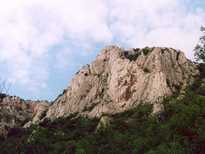
High rising rock alongside the gap
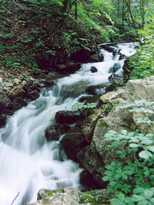
Lovely murmuring brook along the road through the gap
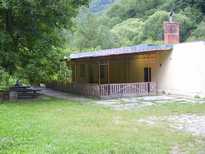
The 'cosy', Soviet Bloc era, restaurant

View over the surroundings from the rocks after a strenuous climb
To the west, towards Bratislava
The next day, after breakfast, we packed all our things and loaded them into the car. After saying goodbye to Harrie, Jana and the dog Demi we left around a quarter to ten towards
the western part of Slovakia, to its capital Bratislava. According Harrie it would take us about five hours to reach it and all the way you follow the E571. For the greater part
it is still a 2-lane highway which is quite annoying when you're behind a number of trucks creeping up a mountain with 10 km/hr. There are also many curves in the road that make
taking over a slow lorry a long and tedious operation. So you don't make progress on these stretches of road. The Slovak people themselves by the way are more adapted to these
situations. With a real contempt of death they start taking over right before an obscure curve. On one occasion we saw a Slovak, who was taking over a truck, being overtaken by
someone else. So three cars next to each other were racing up a hill while a bus was descending from the opposite direction, it all went just right. Although regularly you see
crosses with some flowers to the side of road, markings of a not so successful overtake manoeuvre. At a gas station near the town of Zvolen we had some buns and something to drink.
From Zvolen onwards there are more and longer stretches of 4-lane highway so we could make more progress from that point onwards. At about a quarter past three we arrived at
camping Zlaté Piesky near Bratislava. We didn't make any reservation and unfortunately we could only stay for two nights in a bungalow instead of the four nights that we
had planned to stay here (BEWARE: I have had reports of luggage being stolen from guests of this campsite!!).
When we go visit Bratislava we will inform at the Tourist Office whether there are other places to stay. The weather by the way has been dry until
now for the whole day, although the sky looked threatening all day. Arjan and Ciska took a long discovery tour around the large campground, while they were doing so it started
to rain when Ciska was enjoying herself in the playground. When the weather cleared a bit they returned to the bungalow. In the meantime Hilleke informed about where an ATM
could be found and a supermarket. The supermarket (Telco) is only about 500 metres away and there they also have an ATM. On our way to the supermarket, Hilleke put our laundry
in a washing machine and then we did some shopping for dinner and breakfast. Because now, after 1½ week of pampering, we have to prepare our own meals. Tesco is a very
large supermarket, open 24 hours per day. It took a while before we had everything we needed and could return to our bungalow. In the meantime the laundry was finished and while
Arjan and Ciska put it up to dry, Hilleke cooked dinner. The question only is whether it will dry as it now is almost constantly raining. Now and then it really poured down.
Sometime later, when Arjan switched on the light in the toilet, we heard a loud bang and we saw smoke coming from the fuse box and all lights went out. Only the boiler and the
electric cooker kept working. After a delicious dinner, Arjan took Ciska to bed while Hilleke went to the reception to pay the bill and to report that all lights went out.
Sometime later a technician arrived that repaired it. Probably the fridge is broken (short-circuit), tomorrow we will receive another one.
On many places in Slovakia you may find extensive fields with sunflowers


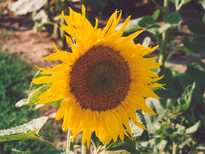
Bratislava
The next day it was the 16th of July, Hillekes birthday. When we got out of bed it was raining again, a dull grey sky. After wishing Hilleke many happy returns we had breakfast
on the terrace in front our bungalow. The laundry we did the day before was hardly any dryer. After breakfast we decided to visit Bratislava, despite the bad weather. Well see what there
is to do when the weather is bad. On our way to the centre, it was only a short dry, we saw some blue spots appearing in between the grey clouds and the rain had also stopped.
When we arrived in the centre we drove around to find a suitable parking place. In the meantime the weather had completely cleared-up, we saw some friendly smiling white clouds
against a bright blue background. We already regretted that we took our coats with us. On the central square Hlavné Námiestie, we first had coffee with cake to
celebrate Hilleke's birthday. It is a coincidence that this year we also celebrate her birthday in the capital of a country, just like last year in Helsinki, Finland
After this treat we went to the Tourist Office to see if they can provide us with a place to stay for Saturday and Sunday somewhere out of town. But they only have addresses in town,
but they were able to give us the addresses of some Tourist Offices in some other places near Bratislava. From the Tourist Office we walked through the old part of the town. We also
climbed up to the castle with is situated on a hill above the town along the banks of the Danube river. From there you have a beautiful view over the town, the old part as well as
the new parts on the other bank of the river. We didn't visit the castle, as it is a museum nowadays as we didn't want to wander around there. During our walk through the town we
regularly stopped to have something to drink, it was very warm and sultry and we expected a thunder-shower by the end of the day. The sky, by the way, one moment is was a clear blue sky and
sometime later it looked very grey as it could start raining any moment. Apart from only a few drops we didn't had any rain during our walk. At the end of the afternoon we also
did a city tour in a kind of road train. As we were the only tourists in the train they provided us with explanations in Dutch (we are from the Netherlands). After the city tour
we went back to our car to have dinner in a Slovak Pub. Hilleke had seen a leaflet of the pub at the Tourist Office and as it was her birthday she decided that she wants to
have dinner in that Slovak Pub. We had some troubles reaching it by car, some roads were closed and other streets were one-way streets. Finally we found a parking place and walked
the last part. We had a great dinner in the Slovak Pub. After dinner we went back to the camping. At the reception we picked up our cool box that we left there this morning in the
fridge as ours was broken. Back at our bungalow it turned out that Hilleke had lost the key of the front door. We searched everything, coats, cars, etc., nowhere to find. She
was afraid that she had lost it this morning when she took of her coat at the first restaurant to put it in out backpack. So at the end we picked up a spare key at the reception.
In the meantime Arjan took off the laundry that had dried during this beautiful sunny day. With the spare key we could finally enter our bungalow and saw that they had
replaced the refrigerator. It turned out that the fridge was not the cause of the electrical problems we had as sometime later the fuse blowed again and all lights went out.
This time for that matter we were able to repair it ourselves.
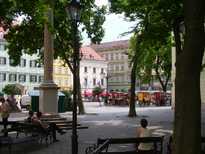
The central Hlavné Námiestie square in Bratislava
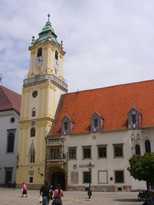
Museum in the former town hall
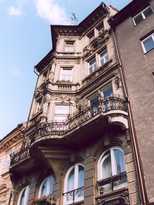
Characteristic façade in Bratislava
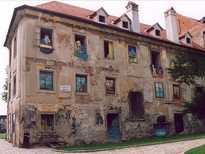
Old house with artistic painted windows
On a few places in Bratislava you may find the characteristic statues shown below
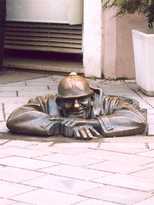
Ladies watch out, this sewer man looks right under your skirts
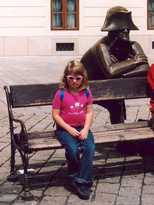
This soldier listens to all your conversations
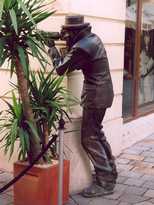
Wherever you go in Bratislava, spies are everywhere
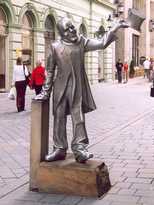
This man once lived, inhabitants of the city gave him food
Surroundings of Bratislava
The next day we got up early, as we had to check out from the bungalow before 10 am. After breakfast at our terrace we packed everything in the car. The suddenly, Hilleke
remembered where she had put the key of our bungalow, in her waistcoat. Yesterday, when we left, she first had her waistcoat on. And indeed, luckily the key was still in her waistcoat.
That will save us a security of 500 SKK. After we had checked out, we first went to Pezinok, a small town north of Bratislava to go to the Tourist Office. We had some difficulty in
finding it. We asked a car-park attendant, but he didn't know, finally it turned out it was only 100 metres from that very spot. At the Tourist Office they had a portfolio with
addresses of hotels, pensions, etc. We saw a nice hotel with some nice looking chalets next to it. The lady of the Tourist Office made a phone-call and made reservations for us.
We also took a wine-tour map of the surroundings with us. In this part of Slovakia, north of the capital, you may find many vineyards. Before we went to the hotel we first wandered
around in Pezinok. In about one and a half hour you have seen it all. The hotel is in a small village, Svätý Jur, just south of Pezinok and the hotel is named
Horský-Hotel Eva. The lady at the reception only spoke Slovak, no English or German, so the communication was a bit troublesome. We had to pay 2000 SKK for two nights and
then she lead us to a hotel room. That was not what we meant. It turned out that the lady at Tourist Office had booked a hotel room and not a chalet. We were then able to explain her
that we wanted to stay in a chalet and not in the hotel. Finally she understood and she phoned someone else, the reception of the chalets. Sometime later they called back to say
that there was place for us to stay. So we went there, the chalets are right behind the hotel. The lady at the reception over there also only spoke Slovak and again with some trouble
we were able to ask her that we wanted to stay in one of the chalets. She then preceded us up onto a dark stair, on the way she pointed us the toilet and bathroom. Up the stairs we came
in a small dark room with three filthy beds. That was not what we had in mind. It turned out that the two chalets have a number of small rooms that you can rent. So we went back
to the hotel and took a room there as we didn't feel like searching any further. After we had put all our stuff in the room, which was very large and very clean, we left to explore
this wine-country. Along the way we stopped several times to quench our thirst, it was again a very warm day. On our tour we also passed the Čeverný Kameň castle where we stopped.
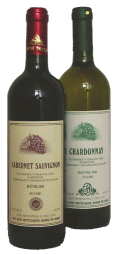 There we first had something to eat and drink and Ciska went for a ride on a pony. Then we walked towards the castle itself, along the way we saw that there would be a bird of prey show
at 16:15. That looked like fun, but that was to begin in half an hour so we decided first to see the courtyard of the castle. In the courtyard there was small vinothèque that
we decided to enter. We tasted some wine and finally we left the small shop with 6 bottles + 1 for free. After putting the bottles in the car it was about time for the bird show
to begin. There were several very large birds of prey that flew very low over the audience, sometimes so low that you could feel them and had to hunch. Some of the birds were
set free from the castle. Amongst the birds that we saw were eagle owls, several ravens and crows, a buzzard, a falcon, a tawny eagle and a golden eagle. After the show was over we
walked along some cages with even more birds. Ciska also had a very heavy eagle owl (almost have of what she weighs) on her arm for making a picture. She thought the bird was very
heavy, so heavy that a boy belonging to the show had to support her arms. That was something she dared do to, but the small Tarantula spider, back in Żywiec, she didn't like.
After all we didn't visit the castle and we went to Trnava to have dinner. We picked this somewhat larger town as they probably have a restaurant where they speak English or
German and have a menu in any of these languages. In those situations a travel dictionary is of no use, most things are not listed. After a delicious dinner we went back to the hotel.
There we first had something to eat and drink and Ciska went for a ride on a pony. Then we walked towards the castle itself, along the way we saw that there would be a bird of prey show
at 16:15. That looked like fun, but that was to begin in half an hour so we decided first to see the courtyard of the castle. In the courtyard there was small vinothèque that
we decided to enter. We tasted some wine and finally we left the small shop with 6 bottles + 1 for free. After putting the bottles in the car it was about time for the bird show
to begin. There were several very large birds of prey that flew very low over the audience, sometimes so low that you could feel them and had to hunch. Some of the birds were
set free from the castle. Amongst the birds that we saw were eagle owls, several ravens and crows, a buzzard, a falcon, a tawny eagle and a golden eagle. After the show was over we
walked along some cages with even more birds. Ciska also had a very heavy eagle owl (almost have of what she weighs) on her arm for making a picture. She thought the bird was very
heavy, so heavy that a boy belonging to the show had to support her arms. That was something she dared do to, but the small Tarantula spider, back in Żywiec, she didn't like.
After all we didn't visit the castle and we went to Trnava to have dinner. We picked this somewhat larger town as they probably have a restaurant where they speak English or
German and have a menu in any of these languages. In those situations a travel dictionary is of no use, most things are not listed. After a delicious dinner we went back to the hotel.
 There we first had something to eat and drink and Ciska went for a ride on a pony. Then we walked towards the castle itself, along the way we saw that there would be a bird of prey show
at 16:15. That looked like fun, but that was to begin in half an hour so we decided first to see the courtyard of the castle. In the courtyard there was small vinothèque that
we decided to enter. We tasted some wine and finally we left the small shop with 6 bottles + 1 for free. After putting the bottles in the car it was about time for the bird show
to begin. There were several very large birds of prey that flew very low over the audience, sometimes so low that you could feel them and had to hunch. Some of the birds were
set free from the castle. Amongst the birds that we saw were eagle owls, several ravens and crows, a buzzard, a falcon, a tawny eagle and a golden eagle. After the show was over we
walked along some cages with even more birds. Ciska also had a very heavy eagle owl (almost have of what she weighs) on her arm for making a picture. She thought the bird was very
heavy, so heavy that a boy belonging to the show had to support her arms. That was something she dared do to, but the small Tarantula spider, back in Żywiec, she didn't like.
After all we didn't visit the castle and we went to Trnava to have dinner. We picked this somewhat larger town as they probably have a restaurant where they speak English or
German and have a menu in any of these languages. In those situations a travel dictionary is of no use, most things are not listed. After a delicious dinner we went back to the hotel.
There we first had something to eat and drink and Ciska went for a ride on a pony. Then we walked towards the castle itself, along the way we saw that there would be a bird of prey show
at 16:15. That looked like fun, but that was to begin in half an hour so we decided first to see the courtyard of the castle. In the courtyard there was small vinothèque that
we decided to enter. We tasted some wine and finally we left the small shop with 6 bottles + 1 for free. After putting the bottles in the car it was about time for the bird show
to begin. There were several very large birds of prey that flew very low over the audience, sometimes so low that you could feel them and had to hunch. Some of the birds were
set free from the castle. Amongst the birds that we saw were eagle owls, several ravens and crows, a buzzard, a falcon, a tawny eagle and a golden eagle. After the show was over we
walked along some cages with even more birds. Ciska also had a very heavy eagle owl (almost have of what she weighs) on her arm for making a picture. She thought the bird was very
heavy, so heavy that a boy belonging to the show had to support her arms. That was something she dared do to, but the small Tarantula spider, back in Żywiec, she didn't like.
After all we didn't visit the castle and we went to Trnava to have dinner. We picked this somewhat larger town as they probably have a restaurant where they speak English or
German and have a menu in any of these languages. In those situations a travel dictionary is of no use, most things are not listed. After a delicious dinner we went back to the hotel.
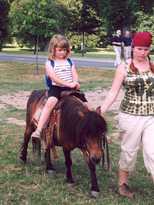
Ponyriding at the Čeverný Kameň castle
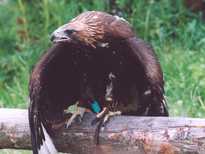
Golden eagle
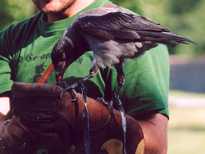
Hooded crow at the bird of prey show near the castle
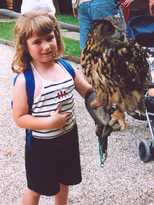
Ciska with a large Eagle owl on her arm
The next day after breakfast we left to explore more of this part of Slovakia. From our hotel we went north via Pezinok, Modra, Trstín, Bukova, Plavecký Mikuláš,
Lakšárska Nová Ves and Závod towards Malacky. In this area you will drive through the Slovak wine-country. Everywhere you see vineyards against the
mountain-slopes. From Malacky we continued via Borinka, Marianka and Bratislava and more or less along the banks of the Danube river via Šamorín, Dunajska Stredá and
Veľký Meder towards Komárno. In a leaflet that we got from the Slovak Tourist Bureau in the Netherlands Hilleke had seen some nice pictures of this town near the
border with Hungary. In this town there is the so-called Europe Place, a square with a number of buildings in an architectural style from 26 different European countries. After we
had something to drink we admired this very beautiful and colourful square. This town is definitely worth it to drive such a long distance for to see it, it is about 100 km from
Bratislava. The road is not very busy (well, at least on a Sunday) so you can make good progress. On the faster parts you only have to watch out for the slow vehicles from the
Soviet Bloc past, the Trabant, Wartburg and old Skoda cars are racing with 60, 70 km/hr over the highway and if you don't take care you will drive at their back after an obscure curve.
After visiting the bloody hot Komárno we went back to our hotel and the rest of the afternoon we relaxed by the pool of the hotel.
Below some pictures of the beautiful, colourful Europe place in Komárno

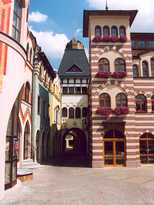
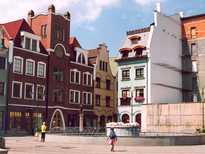
Onwards to the Czech Republic
The next day around 8 o'clock we sat at the 'pleasant' breakfast in our hotel. It is obvious that the word breakfast buffer hasn't made its entry into this part of the world yet. On the
table are three plates with some slices of ham and/or cheese and some butter, marmalade and honey. There is also a basket with some bread and a large can of tea with sugar.
No coffee, but they can make it when you ask for it. The knifes are not sharp at all, the back of a fork is even sharper for cutting your bread. After breakfast
we packed all our things in the car and left for the Czech Republic. First we went to a town called Holíč, right before the border. Hilleke had read somewhere that there
ought to be an old windmill in that place. But we were not able to find it. It was marked on a city map, but there was no way to get there. We even didn't grasp a glimpse of it.
At a local supermarket we did some shopping for lunch and we had an ice-cream at the town square and something to drink at a restaurant. After that we drove to the border. No waiting
times there, the custom-house officer briefly checked our passports and within only a minute we were at the Czech side of the border. On our way to Kromĕříž
we stopped in some place and on a bench in the park we had our lunch and the melon we bought the day before at a roadside stand on our way back from Komárno.
After a delicious lunch we continued towards Kromĕříž. On the way the sky suddenly turned dark and some moments later it started to rain. In only a few minutes time
the temperature dropped from 33 to 26 degrees Celsius, unfortunately the shower was only very short, but the temperature stayed well below 30 degrees. In Kromĕříž
we first went to the Tourist Office at the central square to inform about the possibilities for staying the night in the neighbourhood. We wanted to stay for five nights in a cottage.
The friendly lady of the Tourist Office showed us Tesák, a holiday resort in the mountains with a hotel and some cottages. She phoned them and made reservations for a cottage
for us and showed us on a map how to get there. On the square we then had something to drink and after that we admired the splendidly restored centre of the town with a great square
with buildings coloured like candies. In the Czech Republic you will get a 70% subsidy when you have your old house restored. That's why a lot of Czech cities have a beautiful
town square with splendidly restored houses with façades in candy-like colours. In the internet cafe at the town square we checked our e-mail and then it was about time
to find Tesák near a village called Rajnochovice. The road to Rajnochovice was not that difficult, but to find the Tesák holiday resort was more of a problem. The lady
at the Tourist Office had told us to follow the signs, but those were nowhere to see. At some point in time we asked a young lady on a bike. But she hardly spoke any English or
German. First she said we had to go back, then we had to follow the road, all with a lot of giggling in very bad English mixed with Czech. Finally she only spoke Czech, which we do not
understand. We returned back to Rajnochovice and at a junction we went into another direction. There we also couldn't find it and returned and asked at another holiday resort. They
told us we were at the right direction and have to continue for another 6 km. So we did, but still no sign of Tesák. We continued for a few more kilometres and asked again.
Those people told us we were heading in the right direction but we had to continue for another 10 km. Finally, when we were about to give up, we arrived at Tesák. It turned out
that the lady at the Tourist Office gave us incorrect driving directions. When we spoke to the owner of the complex it turned out that all cottages were occupied and the only thing he
could offer us was a old, worn out, hotel room. The lady at the Tourist Office must have known that and have booked the hotel room for us without telling us. After checking the room we
decided we did not want to stay there, so we returned back to Kromĕříž to find a decent hotel. We finally found a large room in a hotel adjoining the town square.
We also had dinner there. This last part of the day was very dreadful, we will only stay for one night in this hotel and continue our search for a pleasant stay tomorrow.
Kromĕříž
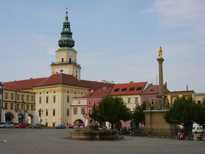
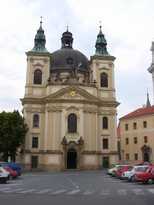

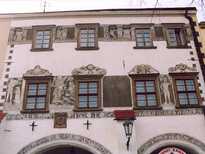




Olomouc and Litomyšl
The next day, Hilleke and Ciska went shopping and Arjan went to the internet cafe to find a place to stay for the coming nights. But the internet cafe was still closed and it would open
at 10 o'clock. After it had opened it doors we found a number of addresses to stay the coming nights. While Arjan continued searching, Hilleke started to phone a few of them to
inquire whether it would be possible to stay the coming nights. Sometime later she returned saying she made reservations for a cottage on camping Dolce Vita in a village called
Oblanov Dolce near Trutnov, near the border with Poland. After making the reservations we went back to the hotel to hand-in our room key and the parking ticket and then we left
Kromĕříž. According an article we read, there a number of beautiful squares to see in the towns of Olomouc and Litomyšl. First we went to Olomouc, we arrived
there around noon. After parking our car we went to a terrace next to the 15th century astronomical clock to have something to drink. The astronomical clock is a real beauty. The city has
a large number of fountains. One of them is one the Horní Námĕstí, the central square of Olomouc. While Hilleke went to the post-office to buy some stamps, Ciska
and Arjan walked to that fountain. This fountain has a number of spouting dolphins and other animals. It is a real children's fountain. A lot of children are walking through the water.
Also Ciska took of her shoes and walked through the cool water of the water. On a certain moment she slipped, resulting in a wet pair of pants, for her that was the end of walking in the
fountain. After that we walked through the centre of Olomouc before continuing our trip to the next town, Litomyšl.
Olomouc

The beautiful astronomical clock
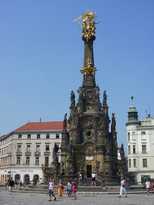
The enormous plaque column
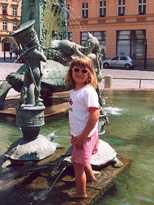
Ciska in the animal fountain

The beautiful astronomical clock

The enormous plaque column

Ciska in the animal fountain
In Litomyšl we arrived about one hour later. Also here a square, long and narrow this time, with a statue of the composer Bedřich Smetana who was born in Litomyšl.
It is a pity that there are a lot cars parked along the sides of the square, they spoil the view on the beautiful façades of the buildings. After having a drink we walked to
the beautiful renaissance castle of Litomyšl. This castle was build between 1568 and 1573. What is special about this castle are the outer walls, the are completely covered in
sgraffito, this is a renaissance way of painting. Large bricks are painted on the walls and the outside is covered with fine pictures. As it already was rather late and we had to drive a
long way to the camping we walked back to our car. Via a street with wall paintings in sgraffito of the book 'Bloody Novel' of the author Vachal we ended up at the central Smetana square.
Before we left we bought some bread at a backery to eat along the way. The road towards Trutnov leads you through a beautiful landscape, the road are again mostly 2-lanes hwich means that
the large number of trucks on the roads cause a lot of delay. So when there is an opportunity to pass, you have to be fast. Switchback and with a quick turn around the truck. Probably
because of all this swinging and fast accelerations suddenly Ciska didn't feel very well. Hilleke grabbed a vomit-bag and she kept it in front of Ciska right on time. Luckily she poured
everything in the bag and nothing on her clothes or in the car. This is the second time this vacation that she has to throw up in the car. Via a large city, Hradec Králové,
where we didn't stop, we drove towards Trutnov. Not long after we arrived at the camping. The coming nights we are staying at the upper storey of a wooden cottage with 4 beds, a toilet
and a shower. It had no kitchen or any other means for cooking and unfortunately also no fridge. There are a lot of people from the Netherlands on the camping, probably more than half of
the guests are from Holland. It is very warm in our room, the whole day the sun was burning on the slanted roof. We had in dinner in the restaurant of the camping. Only the service in the
was very slow and the music was rather loud, so it took us long time to finish dinner and could return to our cabin.
Litomyšl
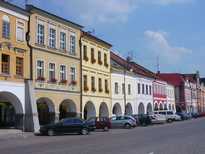
Houses along the Smetana square
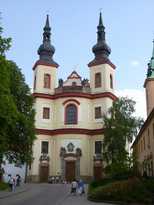
Piarist church

The splendidly painted castle

View in J. Vachal street
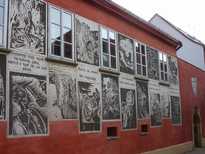
Scenes from the 'Bloody Novel' in sgraffito

Houses along the Smetana square

Piarist church

The splendidly painted castle

View in J. Vachal street

Scenes from the 'Bloody Novel' in sgraffito
Camping Dolce Vita and surroundings
After a night with some rain we went to the restaurant to have breakfast. After breakfast we went to the Trutnov. On the way to Trutnov we stopped at a large supermarket where we bought
a small refrigerator that works on 12V in the car as well as 220V in the cottage. In Trutnov we parked our car near the centre of town and we went to the Tourist Office to get some
information about the town and its surroundings. After we had something to drink we went to see the central square. All those towns all have such an attractive central square with shops
and restaurants around it, a fountain and some benches. One is larger and/or more beautiful than the other, but in most places you may find such a square. The one is Trutnov isn't really
big and also not very special, but there are some interesting façades to admire. Because Hilleke had made reservation for the washing machine at the camping for three o'clock we
went back to the camping around 2:30. Back at the campground, Hilleke did the laundry while Arjan replaced the broken headlight of the car. After that we walked to the lake with Ciska
for a swim. The water wasn't very clean, but Ciska enjoyed herself very much in the water as well as in the nearby playground. After Hilleke having done a second laundry we went back to
Trutnov to have dinner at one of the restaurants at the square. After dinner we drove back to our cottage where we arrived around 10 o'clock. We put Ciska to bed immediately, it was
again late for her.
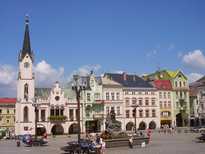
Buildings at the town square in Trutnov
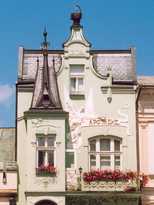
façade of the former chemist's shop
The next day we went to Harrachov near the Polish border. Hilleke had read about a cogwheel train in some leaflet. The laundry was still drying outside on the clothes-line and
although the sky looked threatening we decided to keep it there as it was still not completely dry. Via some local roads we went to Harrachov. The last part there were a lot of trucks
on the road so it took some time before we arrived in Harrachov. In Harrachov we first went to the Tourist Office to buy a map and get a timetable of the train. We thought the train
would leave at 11:26, so we had to hurry to be in time at the railway station. But we misunderstood the timetable; the first train to Tanvald from Harrachov was about to leave at
12:53. So we went back to Harrachov to have lunch. Harrachov is also a famous Czech ski resort, everywhere you see ski-runs and some ski-jumps. Also now in summer it is a popular
tourist destination. Everywhere fully boarded boarding houses and hotels. Around 12:30 we left again to go to the station. The train already had arrived so we boarded immediately. The
train left right on time, just outside Harrachov, the railway follows the border with Poland, to the left you see the Czech Republic, to the right you see Poland. After a short time
it started to rain and not just a little bit, it really poured down. Hilleke hoped that it would stay dry at the campground as the laundry was still hanging outside. The railway-line
between Harrachov and Tanvald has a lot of tunnels and because the lights in the train were off, it was really pitch-dark when the train went through one of those tunnels. After stops
in Kořenov, Dolní Polubný en Desná we arrived at 13:19 in Tanvald. Because we have no business to do in Tanvald we decide to take the first train back to
Harrachov. Luckily it had stopped raining. The return train was due to leave at 13:47, but it had some delay, and it left about 10 minutes later. From Tanvald to Harrachov the railway
is inclining and at some points the cogwheel, noticeable by the fast shaking of the train. Back in Harrachov we went to a glas museum, because apart from being a well-known ski-resort,
Harrachov is also famous for its man blown glass. The museum has a lot of very special glassware on display. In the adjacent shop we bough some glassware. Ciska also bough a ring with
a small piece of glass in it. From the glass museum we went back to the camping. On the way back we stopped in Vrchlabi to visit the mini beer brewery. First we went to the Tourist Office
to ask where to find the brewery. When we arrived at the brewery we first visited it, it is located in a hotel-restaurant. You can't go inside the brewery, but as it is so small, it can
be watched through some windows from the adjacent restaurant. Then we had something to eat in the restaurant before returning to our cottage. When we arrived at the campground it turned
out that they also had a lot of rain, it even went into the tents of some of the other guests. Our laundry was also very wet again. Also some of the laundry was blown of the line and had
become very dirty and had to be washed again. The remainder of the evening Ciska played with the girls of the neighbours in the playground. She was very sad when Hilleke picked her up at
around 9:30 because she had to go to bed.
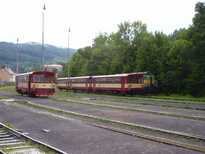
Train at Tanvald station
The last day at the campground we did nothing apart from being lazy. Ciska wanted to play the whole day with the other children and also we didn't want to wander through another city again.
So Ciska spent the whole day swimming in the lake and playing in the playground. Hilleke took care of the laundry which already became dry again as today was again a warm and sunny day.
And Arjan took care of updating our online travelogue on the internet. At the end of the afternoon we drove back to Trutnov to go the internet cafe to search for another place to stay
the coming nights and to upload the updates of our travelogue. The upload couldn't be done as the PCs in the internet cafe had no floppy drive. But we did find another place to stay for
the coming two nights in a boarding-house in Beroun. On a Czech route-finder site we located Beroun. It turns out there are more of them in the Czech Republic. But as there is only one place
that is called Beroun and the others have some post-fix we assume that is the right one. It is in the neighbourhood of Mariánské Láznĕ. As we also want to visit
Prague, Plzeň and Karlovy Vary we have to find another place to stay for another two nights. We also had dinner in a restaurant in Trutnov. As eating out is so cheap here that it
is much easier to go out eating every evening instead of doing your own cooking. After dinner we went back to the camping and enjoyed a nice evening at a campfire.

The lake at Dolce Vita
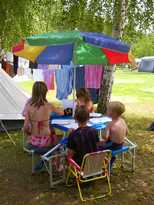
Ciska on the Dolce Vita camping
Plzeň and searching for Beroun
The next day we left the camping after breakfast. Just after we left it started to rain. Initially we went into the direction of Prague. In the first stretch we didn't make much progress
because of the winding roads. After an hour we had only travelled about 45 kilometres. Sometime later we ended up in a traffic jam, due to an accident and one of the lanes was closed.
From Prague onwards to Plzeň it is a four-lane highway on which we could make up some of the time lost earlier. When we arrived in Plzeň we walked to the central square and
admired the town hall from which a newly wed couple left and the next one was standing by to enter the town hall. When such a wedding cortege drives through the streets there is a lot of
hooting and other loud noises. And as we saw several of these corteges when we were in Plzeň we were constantly surrounded by a lot of noise. Most couples marry on a Saturday because
wedding ceremonies last two days and so nobody has to take a day off from work. So on a Saturday it is a coming and going of brides and bridegrooms at the town hall. Because the city of
Plzeň also lent its name to 'pilsener' beer, a large part of the town is dedicated to the beer Pilsener Urquell (Primeval spring of Pilsener). We also made a tour through a part
of the tunnels under the city. In early days these tunnels were used to store storage and for maturing the beer in large casks. There are also many wells with very clear water in the
underground tunnels. During the tour you see about 20 of these wells, but in total there are about 700 of them under the city. The whole tour lasts for about half an hour and
it is very interesting. Also, at last, the explanation of the guide was also in English and not only in Czech. Although we had the idea that our guide told a lot more in Czech than she
did in English. From the Plzeň underground we went to the beer museum, not far from the entrance to the underground world of the city. The museum shows the history of beer making.
A small part is dedicated to the origin of beer, long before Christ, in ancient Egypt. The larger part of the exhibition deals with the history of beer making in this city. This
museum is definitely worth a visit when in Plzeň. After visiting the museum we had a drink on a terrace, it had stopped raining, before we went off for Beroun. Beroun is a very
small hamlet east of Mariánské Láznĕ, our route planner wasn't aware of the place. At last, via small, winding local roads we arrived at around 5 pm in Beroun
where the road ended at farmyard. Also the only crossroad in the hamlet ended at a farmyard. There was no boarding house to be found, especially not in a street that had a house with
number 879. So we continued to the next village, also nothing. At last we drove to the next larger town, Tepla. From there we called the boarding house, it turns out that the Beroun
we need to go to is one of those Berouns with a post-fix appended, just south of Prague. We agreed that we would arrive around 8 pm. From Tepla we drove to another larger town, Plana,
where we had dinner. After also feeding the car we drove to Beroun at high speed. From Plana first on local roads and after a few kilometres on the highway all the way back to Plzeň.
Near Plzeň there is some road construction going on and you have to continue on local roads but after that there is again a nice stretch of 4-lane highway all the way to Prague.
We had to take the exit at Beroun. There we had to search, but luckily there were some signs directing us to the Nostalgie boarding house and at 8 sharp we arrived. A friendly woman with
a little baby on her arms welcomed us and showed us our large room with 3 beds. After we put all our stuff in the room we idled for the remaining part of the evening.
The town hall and some façades in Plzeň
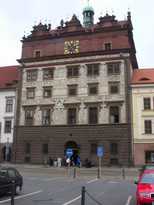
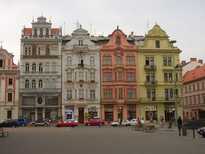
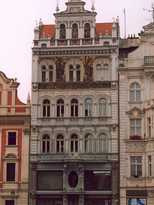
Prague
A daytrip to Prague. With our car we drove to a metro station where we parked the car on a guarded parking place. From there we took the metro to the centre of Prague. The ride lasted
about 30 minutes. On a Prague guide, Hilleke had found a walking tour that guided you along most of the tourist sites in the city, the Royal Tour. The first site we came along was the
Powder Gate. During our walk from the metro station to the Powder Gate we had come along some artistic cows. The so-called 'Cow Parade' is now done in Prague, 4 years ago we had also seen
one in Calgary. Because of all these cows, this day was already a success for Ciska, and we would see a lot more of them during the day.
She had to pet every cow we came along and she also tried to feed them. From the Powder Gate we walked to the Old Town Square (Staromestské Námestí) where we sat down
to have something to drink. Eating in drinking in Prague is much more expensive than in other parts of the Czech Republic, they charge you Western Europe prices. For two coffee and a glass
of apple juice we had to pay 300 crowns, about 10 euro. We walked around the square and admired all sights, including of course the famous astronomical clock in the tower of the city hall.
But, frankly speaking, the only in Olomouc appealed us more than this one in Prague, at that one we could at least determine what time it was. But here in Prague we were not able to read
the time from the clock. After doing dome more sights we returned to the clock at noon to see the procession of the 12 apostles. A large crowd had gathered in front of the clock to see it.
When at 12 o'clock the show was started by the skeleton, depicting Death, by pulling a rope. At that moment a large part of the audience cheered and clapped their hands. While the
skeleton admires the hour-glass in his other hand, two windows opens and 11 apostles and St. Paul show up. After about one minute the show is over and then everyone leaves. Next we walked
via the Little Square (Male Námestí) towards the famous Charles Bridge, also an obvious tourist trap. There are very many tourists and the whole bridge is crammed with
stands at which they sell a lot of rubbish. At the other end of the bridge we stopped at a restaurant to have lunch with a view on the bridge. The weather, by the way, was very warm and
sunny. So we were glad we had a table with a large parasol so we could sit in the shade. After lunch we continued the tour to the Prague Castle. Guided by our guidebook we visited a part
of this vast castle. We started in the large St Vitus's Cathedral. A very nice cathedral on the inside, beautiful stained glass windows and also lots of very fine woodcarvings among which
a large wooden map of Prague in former days. After having visited the crypt we walked to the Golden Lane. In early days the gunners and guards of the Castle lived in this pretty lane.
After another drink we left the castle to find a restaurant to have dinner. Not far from the Castle we found one and after dinner we took the metro and car back to our boarding house.
It had been a tiring and warm day. We have seen very many pretty things, actually one day is too short to visit Prague, there are so many things to see here. Also Ciska had a great day,
mainly due to all the cows scattered all over the city.
Below a number of pictures of Prague
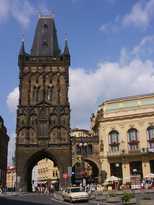
The Powder Gate
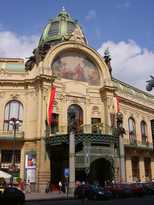
The stately entrance of the Obeční Dům (community house)
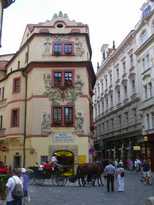
Splendid building near the Old Town Square
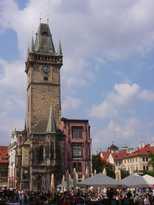
Prague city hall
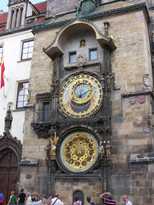
The famous astronomical clock near the city hall
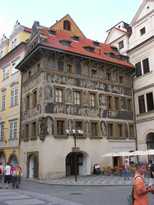
House next to the city hall
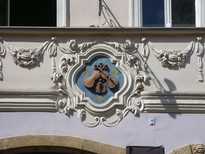
House with the 3 violins
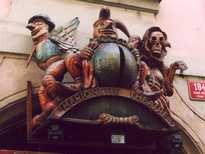
Woodcarving above the entrance of a marionette theatre
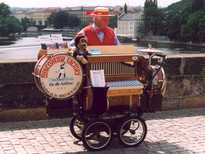
Street-musician on Charles Bridge

The famous Charles Bridge

View on Prague Castle from Charles Bridge
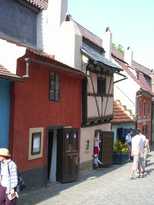
The Golden Lane in Prague Castle
And some cows of the Cow Parade
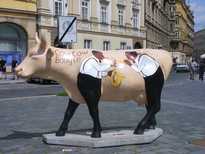
Cow Cow Boogie
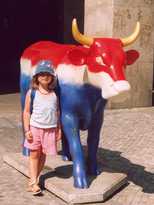
Ciska in front of a Dutch cow
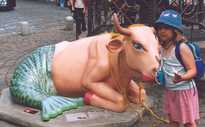
Mercow
Karlstein castle and Mariánské Láznĕ
The next day after breakfast we drove towards Karlstein castle, not far from Beroun. Via winding roads through the mountains we arrived at the parking place near the castle. It is not
allowed to drive all the up to the castle and according a sign at the parking place it was a long and steep road to the castle. But there is also a taxi or horse and carriage that could
take you up the hill. The first one attracted Hilleke, Ciska was more in favour of the second one. When we asked the attendant about the timetable of the taxi it turned out that the
castle is closed on Mondays. Yes, we could have known that, on Mondays most museums and such are closed. But according some people returning it was worth it going through the village
and watch the castle from there. Also the road into the village was not that far and steep. After a short walk we already saw the castle rising high above the village. it really looks
like a castle from a fairy-tale. Most souvenir shops are open on Mondays, but not all. Also here a lot of shops selling Bohemian crystal and glassware. Some items are really beautiful,
but some are also very large or fragile that we doubt whether we will manage to get it home in one piece. We only buy some small things or things that are very well packed. After admiring
the castle from down below we had something to drink before returning to our car to go to Mariánské Láznĕ. Mariánské Láznĕ is
famous for its spas. In and around town there are a lot of mineral springs that are supposed to be healing. After visiting the Tourist Office and lunch we continued our way into town.
It is, by the way, a hopeless city to drive, a lot of one-way streets or streets that you may only enter with a special permit. So you definitely need a map to get from point A to
point B. After parking the car we walked towards the Maxim Gorki Colonnade, one of the main attractions of the city. In the pouring rain, the whole day we had looked at a grey overcast sky. Also
during our trip to this town we had some rain, but from the moment we left the car it really started to pour. At the Colonnade we walked through it and drank mineral water from
a number of springs. Most of them didn't taste very well. What stroke us was the fact that the average age of the people walking around was lowered by our presence, it are mainly elderly
people visiting this place. They probably have the highest needs for the healing water, although all posters only depict beautiful and smiling young women in a bath. Because of the
rain we didn't want to visit more of the town and decided to find an internet cafe to search for a place to stay. It turned out that we had parked our car in front of another Tourist
Office that also had public internet PCs. While Arjan checked the mail, Hilleke organised a place to stay. We are staying in a hotel on a hill just outside town, hotel Panorama.
Via a small and winding road up the hill we arrived at the hotel. Our first impression was one of: "In what kind of decaying mess have we ended up now?". But when we entered the lobby all
looked much better. A lady guided us to our room, but as soon as we left the lobby the sadness of fallen grandeur stroke us. Stairs telling of better times and beautiful leaded glass
windows. We walked over shabby carpets through high, sad looking corridors. The lady told us that we are the only guests in the hotel. The hotel is being renovated, our room was ok,
equipped with a new installed toilet and bathroom. This hotel is one of the oldest in Mariánské Láznĕ, it opened up in 1872. In its glory days it undoubtedly must
have been a very luxurious hotel for that time. But during the communist era the hotel probably was neglected and now it is being restored to its old grandeur with modern luxury. So maybe
in a few years it is again one of the high ranked hotels in this town and you probably have to pay a lot more for a room than we did. After dragging all our luggage up (there is no elevator)
we took a rest in our room before returning to town to have dinner.
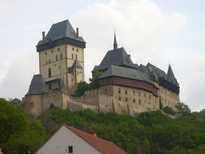
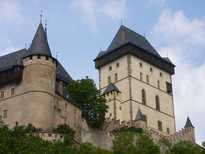
Fairy-tale castle of Karlstein
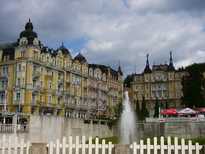
19th century gentleman's houses in Mariánské Láznĕ

The Colonnade in Mariánské Láznĕ
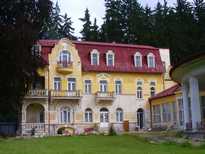
Hotel Panorama
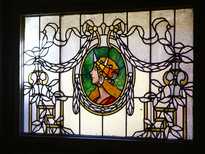
Leaded glass window in the hotel
Karlovy Vary
Daytrip to Karlovy Vary, another even more famous place with spas and other health resorts not far from Mariánské Láznĕ. Karlovy Vary is also a place in which most
of the houses in the old centre are from the mid 19th century. Also Karlovy Vary is a maze with one-way streets, which make getting to your destination in this town not an easy task. But
when we succeeded in finding a parking place we first went to a terrace to have something to drink and next we discovered the town in search for the Tourist Office. Most of the springs in
town can be found at or near several Colonnades. This is the place where the curing people can pick up their 'private' jug and fill it with the sometimes very warm water, sometimes with
temperatures between 50 and 70 °C. We also tried some of the water, and, same as in Mariánské Láznĕ, we didn't like it. We also went for a look at the spring
that was discovered first, the Vřídlo spring or Hot Spring Fountain. This one has a temperature of around 74°C and the water sometimes goes to a height of 12 metres and it
produces large clouds of steam. Many famous people have cured in this place like tsar Peter the Great, emperor Josef II and Johann Sebastian Bach. After walking around it was about time
for lunch and while we were eating it started to rain. But that was already gone before we had finished our lunch. The rest of the day, the sky often looked threatening but there was no
more rain. It wasn't a very warm they as well by the way. After lunch we walked to the cable railway with which you can go to the top of a hill from which you have a splendid view over
Karlovy Vary and its surroundings. On top of that hill there is also a watchtower from which you have an even better view. After having an ice-cream we descended again but we left the
cable-railway at the middle station and walked from there to see the small statue of a chamois that looks out over the city. The legend tells that emperor Charles IV discovered the springs
during a hunting party. A deer jumped over a large rock and his dogs also tried to jump over it, but they ended up in a warm spring. A physician investigated the water and he discovered
that the water had healing effects. The statue of the chamois (not a deer) is a commemoration for this event. From the small statue of the chamois we descended further into town. There
we wandered around some more before returning to our car to drive back to our private hotel. When we arrived there we admired the large ballroom that was opened now, it really looks
impressive. Enormous chandeliers are hanging from a beautifully decorated ceiling and there are large mirrors on the walls, this room definitely has an atmosphere of a long gone era.
When the restoration of the hotel will be ready in a few years from now all will undoubtedly look very impressive again.
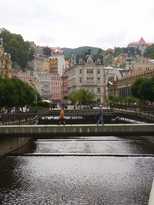
View on Karlovy Vary with the Tepla river

The Park Colonnade in Karlovy Vary.
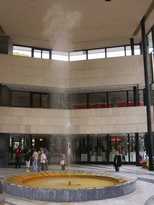
Spouting Vřídlo spring (=Hot Spring)

Tapping water at one of the many springs (Mill Spring)
Towards Germany - Playmobil Funpark
After again another very sumptuous breakfast buffet in our private hotel we packed the car and left into the direction of Germany. The border crossing into Germany went without any
delay, they weren't even interested in our passports, we were allowed to continue without stopping. Once in Germany, we thought that we could make good progress on the German autobahn
towards Nuremberg. But unfortunately, the motorway (A6) from the border towards Nuremberg is still under construction. So large stretches of the road you drive on 2-lane local roads on
which you may think that you are back in one of the former countries when you are driving behind a truck. After a lunch stop at a gas station we arrived in the neighbourhood of
Nuremberg around three in the afternoon. It took some time to find the camping, Knaus Campingpark. We didn't know the exact location of the camping, only that it was to the southeast of
Nuremberg and we also didn't have the address or phone number of the camping with us. But at some point we saw a sign towards a campground, we only hoped that that would be our camping as
it didn't carry a name. And luckily it turned out to be our camping. When we arrived there we wondered whether our reservation would be ok, we knew that our fax didn't arrive and Hilleke
had only a confirmation by phone. But the lady in the office had us in her computer, so there was a rental caravan available for us. The lady took us there. It was an ordinary
caravan without shower and toilet. There are a lot of people from the Netherlands at this campground and a lot of them come here to visit the Playmobil Funpark, just like us, in the cause
of the afternoon we see a lot of people return to the camping with large plastic bags filled with boxes of Playmobil. Also our Dutch neighbours return with some of those bags. They have
a seven year old son, Daniël, who bought some Playmobil. For the remaining part of the day, Ciska played with Daniël and his new Playmobil. And because we are now at a camping
and have our own kitchen again, Hilleke cooked dinner for the second time this holiday.
The next day after breakfast we went to the Playmobil Funpark in Zirndorf, west of the city, a 20 minutes drive from the camping. When we arrived there, Hilleke discovered that she had forgotten her bag with her wallet, it was still in the caravan. Fortunately, Arjan also had some euros in his wallet so at least we were able to pay the entrance fee for the park and the parking garage. Both the entrance fee and parking fee are very cheap, the entrance fee is € 5,50 pp, also for children and parking is euro; 1,- for the whole day. Also eating in the park is not expensive, three people can eat for less than € 10,- in total. They assume that you will spent all your money in the adjoining Playmobil shop. After we entered the park, Hilleke left again to drive to the centre of Zirndorf to draw some money from an ATM. The Playmobil Funpark is a kind of amusement park with for example pirates, Indians, a Maya temple, a farm, etc. Everywhere there are life-size Playmobil figures and animals. There are also a lot of attractions with water, but we didn't bring a bathing suit and towel for Ciska so in all of these attractions she couldn't go any deeper than her knees. There is also a large building in which all children can play with Playmobil, many of the large boxes like the zoo and Noah's ark are available to play with. Also trains and buildings are there for the children to play with. This is inside, so also when the weather is not that good children are able to enjoy oneself. But today the weather is great, a bright blue sky with a few small clouds. It is very warm in the sun and most of the time we try to be in the shade. There is also an indoor activity centre that enables children to clamber and climb. This building is still under construction, but a part of it is already open. Also a good destination in case the weather isn't that good. The whole park is aimed at children; there is not much to do for their parents apart from playing together with their children. Around 3 o'clock we went to the shop. Ciska already had selected some things she wanted to buy. From her own money she bought two giraffes and a baby giraffe, a stork pool and a dolphin. We also gave her some things like a crocodile pool, a panda paradise, a horse and carriage, an animal truck with a kangaroo and some other small things. We didn't buy her the zoo as it is a very large box to take home and it has not that many animals. Now with all the smaller boxes she has much more animals to play with. The Playmobil, by the way, is much cheaper her than with us in the Netherlands. In Holland the zoo will cost you about € 119,- and her it is only € 85,-. Also the smaller boxes are much cheaper her. After having paid for all the stuff we bought we drove to a supermarket to do some shopping for dinner and breakfast and back to the camping. Back there, Ciska and Daniël played the whole afternoon and evening with their new toys.
The next day after breakfast we went to the Playmobil Funpark in Zirndorf, west of the city, a 20 minutes drive from the camping. When we arrived there, Hilleke discovered that she had forgotten her bag with her wallet, it was still in the caravan. Fortunately, Arjan also had some euros in his wallet so at least we were able to pay the entrance fee for the park and the parking garage. Both the entrance fee and parking fee are very cheap, the entrance fee is € 5,50 pp, also for children and parking is euro; 1,- for the whole day. Also eating in the park is not expensive, three people can eat for less than € 10,- in total. They assume that you will spent all your money in the adjoining Playmobil shop. After we entered the park, Hilleke left again to drive to the centre of Zirndorf to draw some money from an ATM. The Playmobil Funpark is a kind of amusement park with for example pirates, Indians, a Maya temple, a farm, etc. Everywhere there are life-size Playmobil figures and animals. There are also a lot of attractions with water, but we didn't bring a bathing suit and towel for Ciska so in all of these attractions she couldn't go any deeper than her knees. There is also a large building in which all children can play with Playmobil, many of the large boxes like the zoo and Noah's ark are available to play with. Also trains and buildings are there for the children to play with. This is inside, so also when the weather is not that good children are able to enjoy oneself. But today the weather is great, a bright blue sky with a few small clouds. It is very warm in the sun and most of the time we try to be in the shade. There is also an indoor activity centre that enables children to clamber and climb. This building is still under construction, but a part of it is already open. Also a good destination in case the weather isn't that good. The whole park is aimed at children; there is not much to do for their parents apart from playing together with their children. Around 3 o'clock we went to the shop. Ciska already had selected some things she wanted to buy. From her own money she bought two giraffes and a baby giraffe, a stork pool and a dolphin. We also gave her some things like a crocodile pool, a panda paradise, a horse and carriage, an animal truck with a kangaroo and some other small things. We didn't buy her the zoo as it is a very large box to take home and it has not that many animals. Now with all the smaller boxes she has much more animals to play with. The Playmobil, by the way, is much cheaper her than with us in the Netherlands. In Holland the zoo will cost you about € 119,- and her it is only € 85,-. Also the smaller boxes are much cheaper her. After having paid for all the stuff we bought we drove to a supermarket to do some shopping for dinner and breakfast and back to the camping. Back there, Ciska and Daniël played the whole afternoon and evening with their new toys.
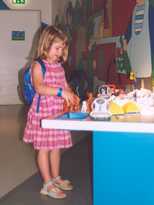
Playing with the Playmobil
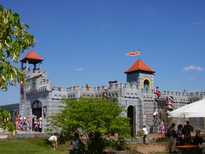
Playmobil castle

Pedal cars for the small ones

On a tiger in the jungle

An old Maya temple

Tipi in Indian country
Bornheim and Cologne
The next morning Ciska also played with Daniël and their Playmobil while we packed the car and cleand the caravan. At 11:30 we left to go to Bornheim-Roisdorf to visit some friends,
Gabi and Martin and their two children. Bornheim is a small town between Cologne and Bonn. The journey from Nuremberg to Bornheim was a fast one; we only had one traffic jam near
Aschaffenberg due to some road construction going on, that took about half an hour. We also saw an accident in the other direction, a Dutch caravan had turned over, a sad ending of a
vacation. Around a quarter to five we arrived in Bornheim. From the highway we had to search as our route planner could nor give us more information than that after we had left the
highway we had to continue on local roads to go to our destination. But finally we arrived there and we were kindly greeted by Gabi and Samuel, the youngest son. Martin and their oldest
son Adriaan came home sometime later. In the evening we had a great barbeque, the weather was still great. And after the children went to bed we had a pleasant evening together.
In he morning the next day we first went together with Gabi to see her horses and also for Ciska to ride on one of them. Gabi gives a therapy to handicapped children with the aid of horses, for this she has about six horses available. When we arrived at the meadow she fist put the other horses apart from one Iceland pony on which Ciska was going to ride. Ciska helped Gabi with brushing the horse and also tapped the horse so it could get acquainted to Ciska. After Gabi had harnessed the horse she put Ciska on it and walked a few rounds with them through the meadow. Ciska was as happy as a king, her vacation now was complete. After this successful event we went back to Bornheim to have lunch. After lunch we all went to visit Cologne. First we visited a chocolate museum where you could see how chocolate is made. There were also some machines on display used for chocolate making and some of them were working. They also show how hollow chocolate figures are made and how the decorations are made on bonbons It is all very fascinating to see. Of course there is an adjoining chocolate shop in which we bought some. After a drink on a terrace we went to the famous Dom (cathedral) of Cologne. It is an enormous cathedral, also very beautiful on the inside. At this moment it is being restored. We didn't climb the towers, of which each has over 500 steps, not a very tempting thing to do on a warm day like this; again it is about 30 degrees. And apart from that it was also rather hazy, so the view from the tower wouldn't be very spectacular. After the visit to the cathedral we drove back to Bornheim for a delicious dinner. Also this evening, after dinner, we had a long and pleasant evening.
In he morning the next day we first went together with Gabi to see her horses and also for Ciska to ride on one of them. Gabi gives a therapy to handicapped children with the aid of horses, for this she has about six horses available. When we arrived at the meadow she fist put the other horses apart from one Iceland pony on which Ciska was going to ride. Ciska helped Gabi with brushing the horse and also tapped the horse so it could get acquainted to Ciska. After Gabi had harnessed the horse she put Ciska on it and walked a few rounds with them through the meadow. Ciska was as happy as a king, her vacation now was complete. After this successful event we went back to Bornheim to have lunch. After lunch we all went to visit Cologne. First we visited a chocolate museum where you could see how chocolate is made. There were also some machines on display used for chocolate making and some of them were working. They also show how hollow chocolate figures are made and how the decorations are made on bonbons It is all very fascinating to see. Of course there is an adjoining chocolate shop in which we bought some. After a drink on a terrace we went to the famous Dom (cathedral) of Cologne. It is an enormous cathedral, also very beautiful on the inside. At this moment it is being restored. We didn't climb the towers, of which each has over 500 steps, not a very tempting thing to do on a warm day like this; again it is about 30 degrees. And apart from that it was also rather hazy, so the view from the tower wouldn't be very spectacular. After the visit to the cathedral we drove back to Bornheim for a delicious dinner. Also this evening, after dinner, we had a long and pleasant evening.

Brushing the horse
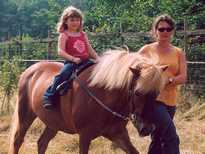
And, guided by Gabi, ride on it

A small part of the famous Dom (cathedral) of Cologne
Back home
Sunday, the first of August, Arjans 40th birthday. After everyone congratulated him with this event we had breakfast. Gabi had put some flowers and a candle near Arjans plate and before
breakfast he was congratulated with a German birthday song while Adriaan was playing the saxophone. Gabi had wrapped Arjan a nice piece of amethyst as birthday gift. Before breakfast,
Hilleke and Adriaan went to the bakery to buy bread and a birthday cake. After breakfast Martin and Adriaan went out to pick mirabelles. These are a kind of small plums, about the size
of small tomatoes and they taste the same as plums. When they returned we cut the cake, a plum cake. After eating the cake, around noon, it was time to say goodbye. The final stretch this
holiday, back home. After a fast journey we arrived at home around three. The end of a great vacation through three new EU member countries and all the way we had no problems, all went well.
The three countries, Poland, Slovakia and the Czech Republic are all very beautiful, especially all the nice city squares, the old cities and the beautiful nature. And all is still very cheap.